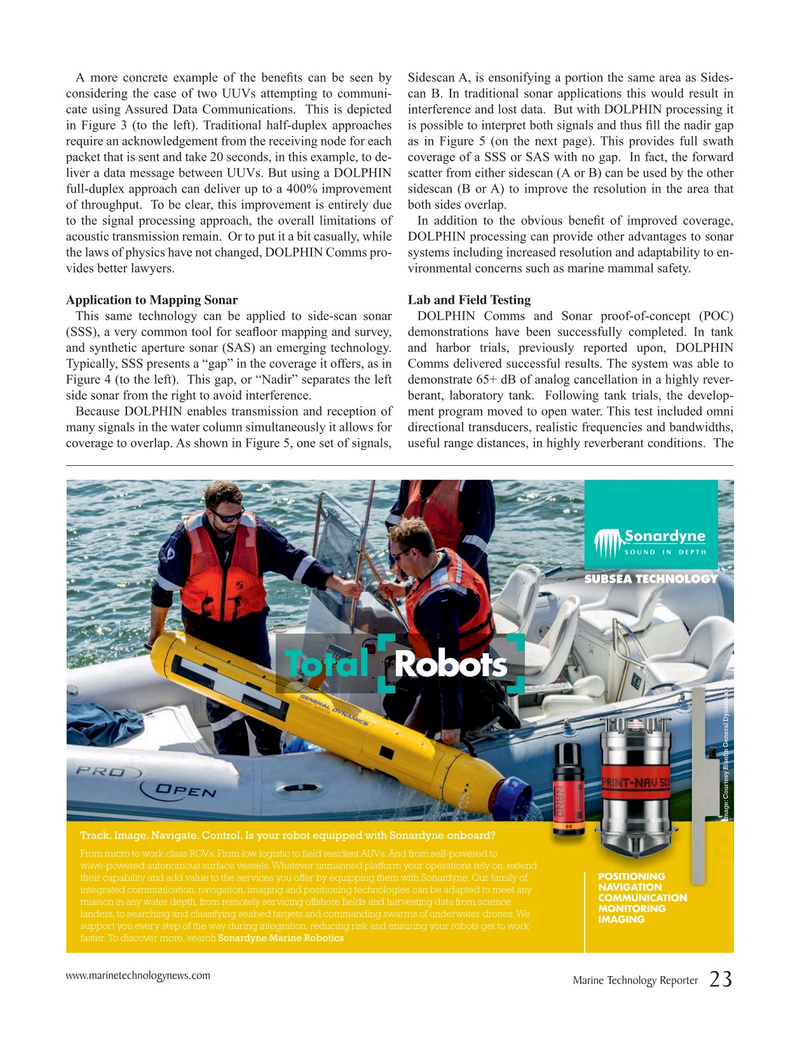
Page 23: of Marine Technology Magazine (May 2019)
Underwater Defense Technology
Read this page in Pdf, Flash or Html5 edition of May 2019 Marine Technology Magazine
A more concrete example of the bene? ts can be seen by Sidescan A, is ensonifying a portion the same area as Sides- considering the case of two UUVs attempting to communi- can B. In traditional sonar applications this would result in cate using Assured Data Communications. This is depicted interference and lost data. But with DOLPHIN processing it in Figure 3 (to the left). Traditional half-duplex approaches is possible to interpret both signals and thus ? ll the nadir gap require an acknowledgement from the receiving node for each as in Figure 5 (on the next page). This provides full swath packet that is sent and take 20 seconds, in this example, to de- coverage of a SSS or SAS with no gap. In fact, the forward liver a data message between UUVs. But using a DOLPHIN scatter from either sidescan (A or B) can be used by the other full-duplex approach can deliver up to a 400% improvement sidescan (B or A) to improve the resolution in the area that of throughput. To be clear, this improvement is entirely due both sides overlap. to the signal processing approach, the overall limitations of In addition to the obvious bene? t of improved coverage, acoustic transmission remain. Or to put it a bit casually, while DOLPHIN processing can provide other advantages to sonar the laws of physics have not changed, DOLPHIN Comms pro- systems including increased resolution and adaptability to en- vides better lawyers. vironmental concerns such as marine mammal safety.
Application to Mapping Sonar Lab and Field Testing
This same technology can be applied to side-scan sonar DOLPHIN Comms and Sonar proof-of-concept (POC) (SSS), a very common tool for sea? oor mapping and survey, demonstrations have been successfully completed. In tank and synthetic aperture sonar (SAS) an emerging technology. and harbor trials, previously reported upon, DOLPHIN
Typically, SSS presents a “gap” in the coverage it offers, as in Comms delivered successful results. The system was able to
Figure 4 (to the left). This gap, or “Nadir” separates the left demonstrate 65+ dB of analog cancellation in a highly rever- side sonar from the right to avoid interference. berant, laboratory tank. Following tank trials, the develop-
Because DOLPHIN enables transmission and reception of ment program moved to open water. This test included omni many signals in the water column simultaneously it allows for directional transducers, realistic frequencies and bandwidths, coverage to overlap. As shown in Figure 5, one set of signals, useful range distances, in highly reverberant conditions. The www.marinetechnologynews.com
Marine Technology Reporter 23
MTR #4 (18-33).indd 23 4/25/2019 9:32:08 AM

 22
22

 24
24
